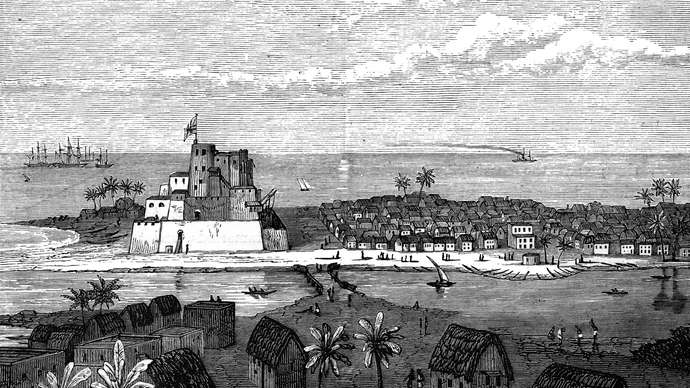Football in a Akan Folk Story. How did it get there?
The Frog and Lizard’s Final Goal, my new children’s picture book, is based on a folk tale. In this story two animals compete against each other in a game of football. I knew that football was a foreign influence and I wondered about it playing such a prominent role in this story. This got me curious to find out how football was introduced in Ghana in the first place and what led to its immense popularity.
To know more, I reached out to Dr. Bella Bello Bitugu, a sociologist, the Director of Sports in the University of Ghana and a Technical Advisor to the Minister of Sports in Ghana. He kindly agreed to tell us how football became so popular in Ghana and the African continent as a whole. I am excited to have Dr. Bitugu here.
QUESTION:
Thank you so much for taking the time talk to us about this. When was football first introduced in Ghana?
ANSWER:
It is a question that is very difficult to answer, because we do not have specific dates. We do know that football was introduced in the mid-19th century, by the colonialists, mainly by the seafarers, and the British merchants, who often docked their ships along the Southern coastal areas of Ghana. The merchants and seafarers needed a leisure activity and they introduced football as a form of recreation for themselves, during their short stays in the country.

Initially the game was meant for the elites – the Caucasian skinned seafarers, and the mulattoes, who were their offspring with local women. But it quickly gathered momentum among the locals.
Football was originally from China and was at the time, gradually undergoing standardization in Britain. The first football club in Ghana, Excelsior, was established in 1903. It was established by a British Jamaican, ironically called Mr. Briton who was then the Head Teacher of the Philip Quaque Government Boys School in Cape Coast. This was followed in 1911 by the first indigenous team, Hearts of Oak, then H.A.S.A.A.C.A.S. in 1931 and later Asante Kotoko in 1935.
QUESTION:
Please give us a little context as to what was happening on the African continent at that time.
ANSWER:
The two major colonial masters, France and England practiced two very different forms of colonialism in Africa. France practiced what was called assimilation, so they could live and integrate with the local people. The most important thing was to eat, drink and sleep French. Once you did that, it was fine.
The British on the other hand practiced segregation: we meet and after that I go my way, you go your way. Also, the colonialism that existed here in Ghana, was different from what existed in Zimbabwe, partly in Kenya and South Africa. What was practiced in these areas was settler colonialism.
On the West Coast of Africa, the British did not come to stay, and there was no motivation whatsoever, to have extended contact with the local people. Most of the schools that were established here by them were for their children, referred to as mulattoes, that were born to these merchants mostly as a result of the rape of the local women.
Interestingly, the British didn’t send to the West Coast what they considered as first choice. The English, the first class citizens, sent their second class citizens, the Irish and the Scotts, to the malaria infested zones of Africa. This policy explains why Scottish names are widespread among the coastal population of Ghana.

The first class citizens, the English, were sent to places with a more temperate climate, like South Africa and Zimbabwe – the settler colonies.
Interestingly enough, beyond West Africa, football became a tool for resistance. For example, when people were not allowed to meet by their colonial masters for fear of resistance, football games became fertile ground for political organization and offered people a way to congregate. The game needed eleven people for each team, a total of twenty-two for both. In some East African countries like Kenya, football was used to help to organize people politically.
QUESTION:
Why did the seafarers and merchants choose football for their recreation, rather than rugby or cricket for example?
ANSWER:
I believe it was the simplicity of the game and the uncomplicated rules governing the game. One only needed a ball, something that the seafarers and merchants could easily transport with them. This is in contrast to games like cricket and rugby which needed more specialized equipment.

QUESTION:
What was it about the game of football that made it so attractive to the population here? What was its appeal?
ANSWER:
It was attractive because of its simplicity. Football is a game with simple rules that could be played everywhere, literally.
By the way that’s how the people started playing football. They stuffed old rags, even used oranges to create a ball. You know how we eat oranges in Ghana by making a whole in the top and sucking out the juice? People used these discarded oranges to play football. People even used lemons.
What one needed to play football was whatever was around – the ground and two stones or two sticks to mark a goal post. Also, one didn’t need style and skill to do it. You just played. The game was easy to understand and required few resources.

QUESTION:
What material were the balls brought in by the British merchants made of?
ANSWER:
The balls brought in by the British merchants, at that time, were made out of leather and were thick and heavy. Football wasn’t played in areas designated for that purpose and that time was a community affair. You could start playing football here in Legon, and end up in Dansoman. So the ball had to be thick to withstand all the wear and tear.
QUESTION:
How did the local population make balls for football? I know of examples out of Ghana where old socks were stuffed with grass and the end sewn roughly to hold it all together.
ANSWER:
The use of old socks was indeed very popular in Ghana and other parts of West Africa. The leaves of the plantain and banana tree were also used to make balls. Several of these leaves were stuffed into each other and tied up with a rope. Of course, these balls weren’t perfectly round but the important thing was that they rolled, and didn’t hurt the foot. In the informal settlements of Nairobi, Kenya, football was promoted to the grassroots as a sport for development. Balls there, were made from old rubber sheets that were folded over several times and held together with rope.
QUESTION:
Are such balls still being used in Ghana as well as other African countries?
ANSWER:
Such balls are still being made and used in the rural areas, though the number has drastically reduced. The standard of living has also risen and balls are relatively cheap.
The balls available back then were limited, and this situation spawned stories such as these: A team would be formed, they play for 5 minutes, and one side scores. If the ball owner’s team is scored, he would get angry, pick his ball and the game would be over. Sometimes the ball owner’s team would negotiate for loses not to be held against them. The children who were lucky enough to own balls, called the shots and determined how things would run. Knowing this, whenever I go with my son to the rural parts of Ghana, we always buy several cheap rubber balls for the children there.

In the city, of course, balls are widely available. But generally I would say that the older, self-made balls are increasingly harder to find around our continent.
QUESTION:
I was struck, when working on The Frog and Lizard’s Final Goal, to discover what a great source of pride it was for both animals, to play football well. It made me realize how deeply ingrained this game is in our culture.
ANSWER:
It is not surprising to me, that these two animals love and compete against each other and that the animals are associated with football. Many football teams are often named after nature, both fauna and flora. Some of these names incorporate the characteristics of animals or plants, which reflect determination, perseverance, endurance and strength.
For example, there is Asante Kotoko – Kotoko the porcupine is quilled and uses its quills to defend itself; Hearts of Oak, the heart but made of oak, the name alluding to the qualities of perseverance and endurance. These names capture what it means to be a sportsperson.
QUESTION:
So would you say then, that The Frog and Lizard’s Final Goal, lauds the qualities of sportsmanship?
ANSWER:
Yes. Undoubtedly!






Wow! Such a creative brain. I love every aspect of this story. Gratitude for taking me way back home again. I had nearly forgotten we had such an awesome Ghanaian story like this.
I am glad you liked this story!